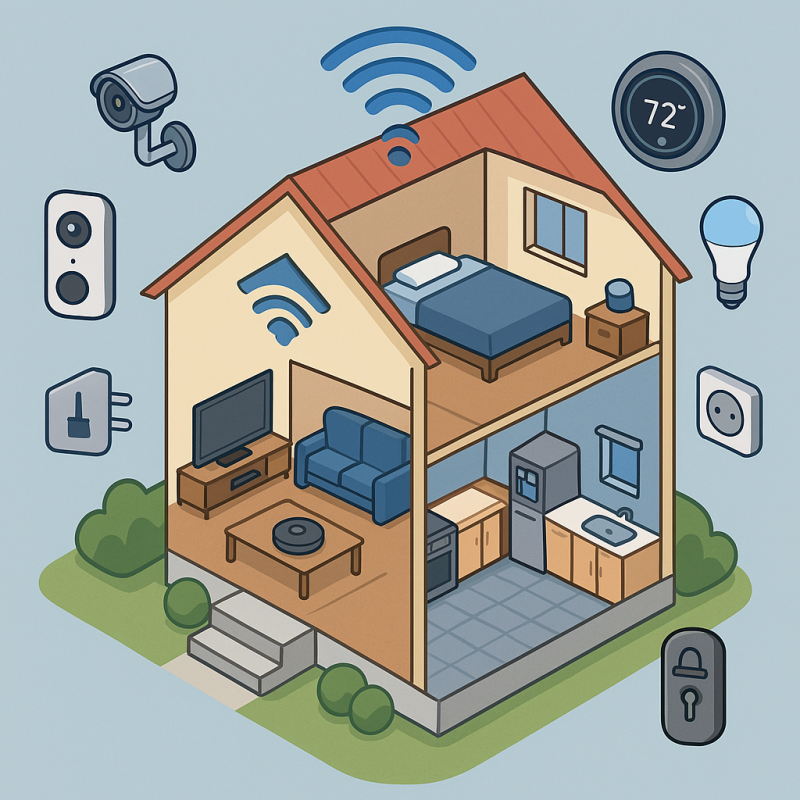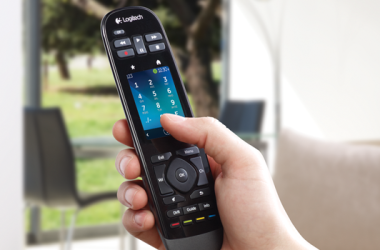Table of Contents Show
In today’s rapidly evolving world, future-proofing your home isn’t just a luxury – it’s quickly becoming a necessity. Smart devices aren’t about flashy tech for tech’s sake; they’re about making your home safer, more efficient, and ultimately, more livable. Whether you’re a tech enthusiast or someone just starting to explore the world of smart homes, understanding which devices actually make a difference can save you time, energy, and money in the long run.
Below, we dive deep into the top smart devices that can truly future-proof your home. These aren’t gimmicks. These are practical, problem-solving tools that elevate the way you live, room by room.
1. Smart Thermostats
Smart thermostats are arguably the gateway drug to home automation – and for good reason. They’ve been around for a while, but the technology has matured to a point where they genuinely learn from your behaviors.
Take the Google Nest Learning Thermostat or Ecobee SmartThermostat, for example. These devices monitor your usage patterns, detect when you’re home or away, and automatically adjust temperature settings to maximize comfort and minimize energy usage. They can even respond to weather changes by pre-heating or cooling your home before a storm or heatwave hits.
Many smart thermostats integrate with weather forecasts and use geofencing, allowing your home’s temperature to automatically adjust as you leave work or head back home. Over time, that efficiency translates into real-world savings. According to the EPA, a properly programmed thermostat can save you up to 10% on heating and cooling annually.
Why it matters:
- Reduces energy waste
- Lowers utility bills
- Enhances comfort
- Enables remote control from your smartphone
2. Smart Lighting
Lighting has a huge impact on the mood, safety, and efficiency of your home. Smart lighting takes traditional bulbs and gives them a digital upgrade. You can dim the lights, change colors, or even schedule them to mimic natural sunlight rhythms – all from your phone or by using voice commands.
Philips Hue, LIFX, and Wyze Bulbs are popular brands offering customizable smart lighting. You can set your lights to gradually brighten as you wake up, change hues to fit your mood, or flash red when your security cameras detect motion.
Plus, integrating your lighting system with motion sensors or a smart assistant allows your lights to turn off when a room is empty – helping you save electricity effortlessly.
Why it matters:
- Improves energy efficiency
- Enhances ambience and mood
- Adds an extra layer of security
- Supports automation routines
3. Smart Security Cameras
Old-school security systems often involve hefty subscriptions and limited monitoring. Modern smart cameras give you more control without locking you into contracts. From doorbell cameras like Ring and Nest Hello to full-blown indoor/outdoor camera systems like Arlo or Eufy, smart security cameras provide high-definition video, night vision, motion alerts, and even facial recognition.
The best part? You can access a live feed or recorded clips from anywhere using your smartphone. Many systems now support cloud storage, two-way communication, and activity zones, ensuring you’re only alerted when it really matters.
Some models even integrate with police departments and neighborhood watch systems for faster emergency response.
Why it matters:
- Real-time monitoring and alerts
- Deters intruders and package thieves
- Easy to install and scalable
- Integrates with smart doorbells, lights, and locks
4. Smart Door Locks
Keys are so 20th century. With smart locks, you can lock and unlock your doors using your phone, voice, or a secure keypad. These devices offer convenience and control while boosting home security.
August Smart Lock, Yale Assure, and Schlage Encode are among the top-rated smart locks on the market. They allow you to create virtual keys for guests, family members, or service providers, and set expiration times for each.
Geofencing features can automatically lock your door when you leave the house and unlock it when you return. And if someone forgets to lock up, you can do it remotely with a tap.
Why it matters:
- Eliminates the need for physical keys
- Allows remote control and monitoring
- Supports guest access with time limits
- Enhances home security with real-time alerts
5. Smart Speakers
Smart speakers have evolved from simple voice assistants to the command center of modern homes. Devices like Amazon Echo, Google Nest Audio, and Apple HomePod not only play music – they control virtually every smart device in your house.
With a simple voice command, you can dim the lights, lock the doors, start your robot vacuum, or hear the weather forecast. These speakers also work with routines and automations, like turning off all lights and setting the thermostat when you say “Goodnight.”
They’re constantly getting smarter, too, with regular software updates and integration with new smart devices.
Why it matters:
- Centralized voice control for your home
- Hands-free assistance
- Integrates with other smart devices
- Enhances accessibility for all ages
6. Smart Plugs
If you don’t want to replace an entire appliance with a smart version, smart plugs offer a clever workaround. Plug any regular device – like a coffee maker, lamp, or space heater – into a smart plug and you can control it via an app or voice assistant.
Devices like TP-Link Kasa, Amazon Smart Plug, and Wemo Mini allow you to schedule on/off times, monitor energy usage, and set up automation rules. They’re especially useful for people who travel frequently or want to automate routines without overhauling their entire home.
Why it matters:
- Low-cost entry point to smart home tech
- Adds automation to existing appliances
- Enables remote control and monitoring
- Great for energy conservation
7. Smart Home Hubs
While many smart devices can operate independently, a smart home hub brings everything together. Hubs allow disparate devices to communicate, creating complex automations that make your home truly “smart.”
Samsung SmartThings, Amazon Echo with Zigbee, and Apple HomeKit are top options. For instance, you can set a rule that locks all doors, lowers the thermostat, turns off lights, and activates security cameras when you say “I’m leaving.”
Some hubs even support IFTTT (If This Then That) protocols, which greatly expand your automation options.
Why it matters:
- Enables device interconnectivity
- Supports complex automation routines
- Simplifies control with a unified interface
- Future-proofs your smart home ecosystem
8. Smart Appliances
Appliances are no longer just large hunks of metal that cook, wash, or refrigerate. Today’s smart appliances are intelligent, connected machines that notify you, adapt to your habits, and optimize performance.
Smart refrigerators can keep track of your groceries, suggest recipes, and sync with your calendar. Smart ovens like the June Oven can recognize food types and cook accordingly. Smart washing machines let you start, stop, or schedule loads from your phone and alert you when a cycle is complete.
These may sound indulgent, but they offer real-world benefits – saving time, reducing energy usage, and adding layers of convenience to your life.
Why it matters:
- Offers remote operation and status updates
- Enhances energy and water efficiency
- Improves food management and cooking
- Integrates with smart routines and voice assistants
9. Smart Blinds and Shades
Smart blinds aren’t just about luxury or aesthetics – they play a role in temperature control and privacy, which in turn affects energy bills and home security.
Brands like Lutron Serena, IKEA Fyrtur, and Soma Smart Shades let you open and close your blinds on a schedule or remotely via app or voice command. Some even adjust automatically based on sunlight intensity or the temperature.
By integrating with your thermostat and lighting systems, smart blinds can create an energy-efficient ecosystem that adapts to the time of day and season.
Why it matters:
- Regulates indoor temperature
- Boosts privacy and security
- Reduces HVAC usage and costs
- Adds convenience and comfort
10. Smart Irrigation Systems
Watering your garden doesn’t need to be a guessing game. Smart irrigation systems like Rachio, RainMachine, and Orbit B-hyve use weather data and soil sensors to tailor watering schedules for optimal efficiency.
These systems prevent overwatering and under-watering, adapting in real time to rainfall and drought conditions. Whether you’re home or away, your garden gets the attention it needs – without wasting a drop.
According to the EPA, up to 50% of outdoor water use is wasted due to inefficiency, so a smart system can significantly reduce both your water footprint and your bill.
Why it matters:
- Conserves water
- Saves money on utilities
- Ensures healthier lawns and gardens
- Offers remote control and automation
11. Smart Smoke and Carbon Monoxide Detectors
Safety first, always. Smart smoke detectors like Nest Protect and First Alert Onelink go beyond beeping. They send alerts to your phone, tell you exactly where the problem is, and can even silence false alarms with a tap.
Some models connect with lighting systems to illuminate your escape path during a fire, or with HVAC systems to shut off airflow and prevent the spread of smoke.
Why it matters:
- Immediate mobile alerts
- Enhanced fire and carbon monoxide safety
- Voice alerts and self-testing features
- Integrates with other safety systems
12. Smart Sensors (Water, Motion, Contact)
Sensors are the unsung heroes of a smart home. Leak sensors notify you of water problems before they cause damage. Motion sensors can turn on lights or trigger alarms. Contact sensors on doors and windows let you know if they’re opened unexpectedly.
Brands like Aqara, Fibaro, and Eve offer a range of multipurpose sensors that enhance security and automation.
Why it matters:
- Provides early warnings for home hazards
- Enhances automation and routines
- Improves security and awareness
- Reduces insurance risk and repair costs
How to Get Started: Smart Home Strategy Tips
Jumping into smart home tech can feel overwhelming. Here’s a quick step-by-step strategy:
| Step | Action | Why It Matters |
|---|---|---|
| 1 | Identify your goals | Security? Energy savings? Convenience? Start here. |
| 2 | Pick a smart ecosystem | Choose between Google, Amazon, or Apple to avoid compatibility issues. |
| 3 | Start small | Begin with lighting or plugs before jumping into advanced setups. |
| 4 | Automate routines | Set schedules for lights, locks, or thermostats to maximize efficiency. |
| 5 | Expand gradually | Add more devices once you’re comfortable with the system. |
Smart Home Security Concerns (And How to Address Them)
No system is without its risks. When you bring smart tech into your home, you’re also potentially exposing yourself to cyber threats. Here’s how to minimize that:
- Use strong, unique passwords for every device
- Enable two-factor authentication where possible
- Keep firmware and apps updated
- Invest in a secure, dedicated smart home Wi-Fi network
Final Thoughts
Future-proofing your home isn’t about chasing every new gadget. It’s about investing in reliable, integrated technologies that solve real problems and evolve with your needs. Whether you’re looking to cut energy costs, boost safety, or streamline everyday tasks, smart devices offer scalable, meaningful upgrades to your living environment.
Done right, a smart home doesn’t just feel futuristic – it works smarter, harder, and better for you.









